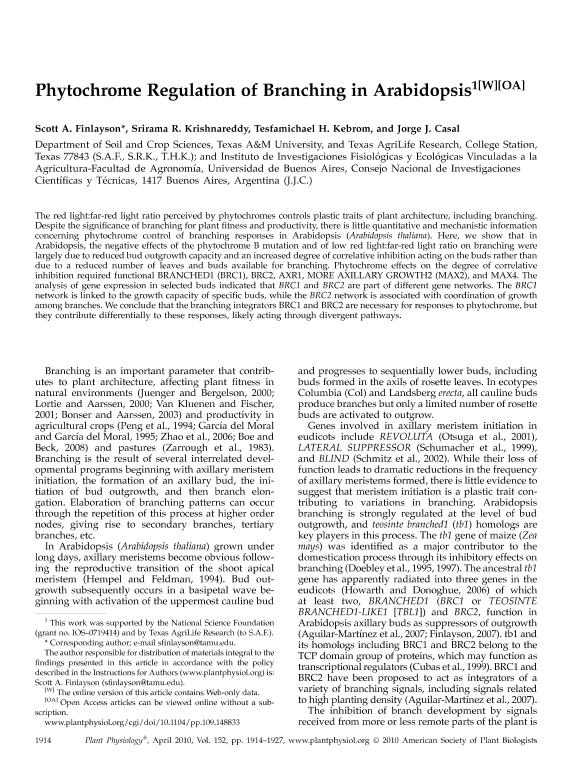Mostrar el registro sencillo del ítem
dc.contributor.author
Finlayson, Scott A.
dc.contributor.author
Krishnareddy, Srirama R.
dc.contributor.author
Kebrom, Tesfamichael H.
dc.contributor.author
Casal, Jorge José

dc.date.available
2019-03-22T16:02:47Z
dc.date.issued
2010-04
dc.identifier.citation
Finlayson, Scott A.; Krishnareddy, Srirama R.; Kebrom, Tesfamichael H.; Casal, Jorge José; Phytochrome regulation of branching in arabidopsis; American Society of Plant Biologist; Plant Physiology; 152; 4; 4-2010; 1914-1927
dc.identifier.issn
0032-0889
dc.identifier.uri
http://hdl.handle.net/11336/72292
dc.description.abstract
The red light:far-red light ratio perceived by phytochromes controls plastic traits of plant architecture, including branching. Despite the significance of branching for plant fitness and productivity, there is little quantitative and mechanistic information concerning phytochrome control of branching responses in Arabidopsis (Arabidopsis thaliana). Here, we show that in Arabidopsis, the negative effects of the phytochrome B mutation and of low red light:far-red light ratio on branching were largely due to reduced bud outgrowth capacity and an increased degree of correlative inhibition acting on the buds rather than due to a reduced number of leaves and buds available for branching. Phytochrome effects on the degree of correlative inhibition required functional BRANCHED1 (BRC1), BRC2, AXR1, MORE AXILLARY GROWTH2 (MAX2), and MAX4. The analysis of gene expression in selected buds indicated that BRC1 and BRC2 are part of different gene networks. The BRC1 network is linked to the growth capacity of specific buds, while the BRC2 network is associated with coordination of growth among branches. We conclude that the branching integrators BRC1 and BRC2 are necessary for responses to phytochrome, but they contribute differentially to these responses, likely acting through divergent pathways. © 2010 American Society of Plant Biologists.
dc.format
application/pdf
dc.language.iso
eng
dc.publisher
American Society of Plant Biologist

dc.rights
info:eu-repo/semantics/openAccess
dc.rights.uri
https://creativecommons.org/licenses/by-nc-sa/2.5/ar/
dc.subject
Branching
dc.subject
Phytochrome
dc.subject
Arabidopsis Thaliana
dc.subject
Development
dc.subject.classification
Otras Ciencias Biológicas

dc.subject.classification
Ciencias Biológicas

dc.subject.classification
CIENCIAS NATURALES Y EXACTAS

dc.title
Phytochrome regulation of branching in arabidopsis
dc.type
info:eu-repo/semantics/article
dc.type
info:ar-repo/semantics/artículo
dc.type
info:eu-repo/semantics/publishedVersion
dc.date.updated
2019-03-08T20:18:39Z
dc.journal.volume
152
dc.journal.number
4
dc.journal.pagination
1914-1927
dc.journal.pais
Estados Unidos

dc.journal.ciudad
Rockville
dc.description.fil
Fil: Finlayson, Scott A.. Texas A&M University; Estados Unidos
dc.description.fil
Fil: Krishnareddy, Srirama R.. Texas A&M University; Estados Unidos
dc.description.fil
Fil: Kebrom, Tesfamichael H.. Texas A&M University; Estados Unidos
dc.description.fil
Fil: Casal, Jorge José. Consejo Nacional de Investigaciones Científicas y Técnicas. Oficina de Coordinación Administrativa Parque Centenario. Instituto de Investigaciones Fisiológicas y Ecológicas Vinculadas a la Agricultura. Universidad de Buenos Aires. Facultad de Agronomía; Argentina
dc.journal.title
Plant Physiology

dc.relation.alternativeid
info:eu-repo/semantics/altIdentifier/doi/https://doi.org/10.1104/pp.109.148833
dc.relation.alternativeid
info:eu-repo/semantics/altIdentifier/url/http://www.plantphysiol.org/content/152/4/1914
Archivos asociados
